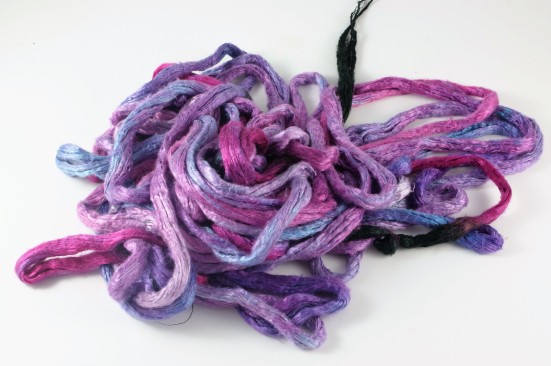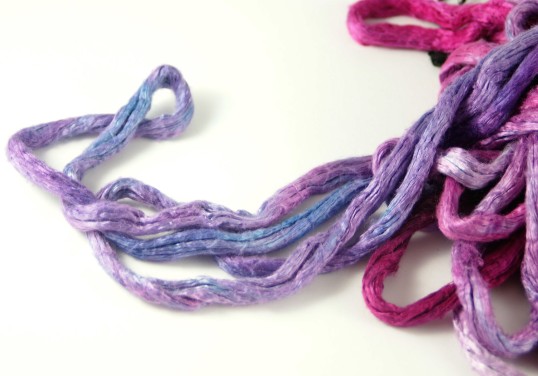While discovering that Procion MX dyes are very happy to dye wools, I came across something else that gave me pause for thought. Although there’s not a wealth of information on using Procion MX dyes with acid, most of the advice that is out there says you need to steam or heat the fibre after applying the dye.

For acid dyes, heating the dyebath is standard practice to help fix the dyes. Fibre reactive dyes, like Procion MX, don’t require this, which is definitely an advantage when trying to do large bits of tie-dying. The standard advice when working with fibre reactive dyes on cellulose fibres and silks is to do your dyeing, then leave your fibre damp with the dye on it for at least a good few hours, closer to 24, if you want strong colours.
As I tend to like very intense, saturated colours, I tend to err on the side of giving the dye a longer reaction time. For some short-sighted reason, I’d always assumed that there was some kind of degradation of the Procion dyes at higher temperatures, hence leaving them to react at ‘room temperature’ but seeing as steaming the wool lately with Procion dyes had worked just fine, that obviously couldn’t be the case.
Was there really a way to go speed up Procion dyeing so I didn’t have to wait so long to see what wonderful mess I’d made?
The answer is, maybe. If you compare this to some previous attempts at using Procion MX on silk, but with waiting 24 hours to leave the dyes with no heating, the colours don’t seem quite as saturated. The best point of comparison are the raspberry patches, which are just unmixed colours at about 5 % dye stock concentrations.


They look quite similar but the rest of the skein has turned out a little lighter than I would have anticipated so I will do some proper testing of this soon to see if an hour in the steamer is equivalent to 24 hours of boredom and of course, share the results here.

I’m not quite sure whether I love or loathe this top overall. The amount of intentional colour variegation has come out very well but I don’t like the overall balance of the top; there’s just too many pale colours in there.

However, the more I dye, the more frustrated I am by not having a full grasp of the chemistry behind the process. I see very few dyeing resources, with the exception of Dharma, that touch much on what is happening at a molecular level.

You don’t need a degree in chemistry at all to produce fantastic results in dyeing but understanding a bit more about the science can cut out a lot of hard work. You can test and sample every idea but if you know that certain dye molecules decompose above 70℃, you can skip testing boiling that dye bath because you won’t end up with what you should. Often, by just looking at a molecular structure, you can guess whether a molecule is likely to fall apart on heating or not as well.

I am a scientist by trade and training and work in a field that strongly emphasises developing a fundamental understanding of processes to save having to do a lot of work. Not that trying to understand things at a fundamental level is always trivial!

Sometimes in the craft community I see a huge phobia of all things tech, science and maths. I find it both incredibly ironic and thoroughly depressing when I see people doing some very complex size conversions on patterns exclaim that they hate maths and could ‘never do any of that stuff’. Knitting and crochet is actually an ideal technique for visualising some very abstract mathematical concepts, and, believe it or not, scientific research is actually a highly creative process.
I’d really like to try and bridge some of these gaps and show how laser technology has as much of a place in dressmaking as a needle and thread. (You can see some example of this from an exhibit I visited at the Boston Museum of Fine Art). I’d love to be able to explain more on why you have to heat acid dyes but not fibre reactive ones and how, even with crafting, science is at the heart of everything we do.

I’m curious though, dear readers, what you would want to know about? Do you want to know why light makes textile colours fade over time? Why dyes react faster at higher temperatures? I’d like to do a monthly piece answering your questions or discussing new craft-related tech in a way that is accessible to someone with just a passing interest in science.
Either email me your thoughts and curiosities at astitchornine@gmail.com or leave them in the comments and I’ll do my best to try and shed some light on some of the mysteries of how things work.
Have you visited Paula Burch’s website? I believe she is a chemist and likes to take things down to the molecular level as well. I haven’t read all the stuff on her site as it can get involved but I’m sure if you have any questions she’d be able to answer them in her blog.
LikeLiked by 1 person
I do love Paula’s site, it’s one of my favourite dyeing resources. Hopefully, one day I’ll be able to contribute something that useful.
LikeLike
Have a look at Catherine Ellis’s book Tge Art and Science of Natural Dyes. It’ll scratch the chemistry itch for you!
LikeLiked by 1 person
Oooh thanks for the recommendation! I will add it to the wishlist.
LikeLike
I think some blogs on understanding the science of dyeing techniques would be very interesting. I experiment with acid and natural dyes and I am curious about the process. Also some posts on color theory would also be interesting.
LikeLiked by 1 person
Thanks for your thoughtful comment and I’ll definitely take all of that into account when thinking about topics. Good excuse to sit and read some interesting literature!
LikeLike